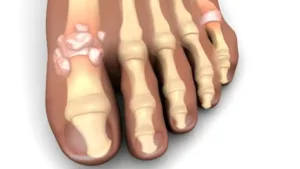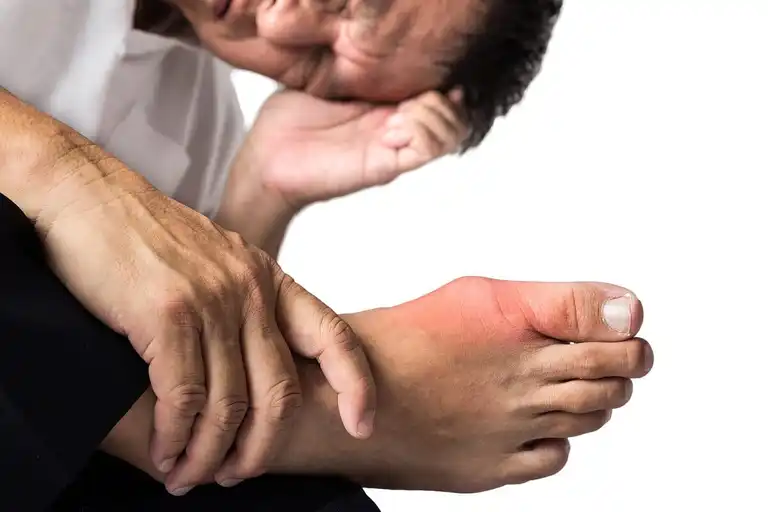The Symptoms and Treatment for Gout

Gout is a condition whose origin is the accumulation of uric acid in the joints (which is known as hyperurisemia). Therefore, it causes severe pain and inflammation. It most often affects the big toe, although it can be located in any other part of the body, such as the ankles, the feet, the knees, the wrists, and even the elbows.
Although we usually think that this condition only affects older people, the MSD Manual clarifies that “gout generally appears in middle-aged men and postmenopausal women. It’s uncommon in young people, but it is usually more severe among those affected who have developed the disease before the age of 30.
In today’s article, we’ll take a look at more about its symptoms and treatment.
What are the symptoms 0f gout?

First, gout causes severe pain in the affected joint and inflammation. In addition, the skin becomes red and shiny. It’s usually in the first toe, and it often involves one joint at a time. In addition, in many cases, it presents with a moderate fever.
Second, when this disease is repeated during the course of life, tophi can form. These are hard-to-touch nodules made up of uric acid crystals that stick around the joints.
Regarding the symptoms, Mayo Clinic experts indicate that:
- A gout attack can appear at any time, and its intensity may vary. Therefore, sometimes it can be more annoying than other times.
- The attack usually involves one joint at a time.
- In general, the symptoms tend to be intermittent. However, they must be controlled so they don’t get worse and cause great discomfort.
- To learn how to control the attacks, follow your doctor’s instructions and keep in mind what we’re going to tell you next. However, in some cases of acute attack, it may be necessary for the doctor to indicate a more specific treatment.
You might also like to read this article: Do You Suffer from Gout? Avoid These 7 Foods
What treatment is recommended to alleviate gout?

Read more about gout here: Natural Aids for Uric Acid and Gout
Primary treatment indications
The first indication to improve and reduce the symptoms caused by gout is to move the joint very carefully when we have to move it. In addition, we must avoid forcing this movement as much as possible. Finally, we can reinforce this advice by applying ice to this part for about ten minutes.
This simple procedure can greatly reduce inflammation, and therefore the pain.
Medical indications
During a medical consultation, some anti-inflammatory medications may be recommended to help reduce swelling and control pain. However, your doctor is the one who must prescribe them. In some cases of acute attack, he or she indicate a more specific treatment.
These medications should never be consumed if they have not been authorized. In addition, in some cases, they can cause significant side effects to a person’s health.
Finally, we must not forget the indications for good health in general. It’s important to drink enough water and maintain a healthy overall body weight.
Dietary measures to control gout
On the other hand, keep in mind that people prone to this health condition should pay close attention to diet. Also, this will help them improve and prevent gout attacks.
To begin with, you must keep in mind that individuals prone to suffering from this health condition should avoid red meat, seafood, innards, concentrated broths, yeast – both in beer and pastries – and alcohol, along with other foods that could increase uric acid production.
Meanwhile, individuals with gout should consume the following foods:
- Eggs
- Dairy
- Olive oil
- Garbanzo beans
- Refined grains without germ (seed)
- Vegetables
- Fruit
- Coffee
- Chocolate
- Gelatin
Finally, foods like white meat, fish, whole grains or grains with germ, sodas, asparagus, spinach, and mushrooms should be consumed in moderation and you should avoid them in excess at all costs if you have gout.
There are lists in which foods are classified by their purine content (high, moderate, and negligible). These can be consulted as a reference, but the best option is to always prioritize what your doctor indicates.
All cited sources were thoroughly reviewed by our team to ensure their quality, reliability, currency, and validity. The bibliography of this article was considered reliable and of academic or scientific accuracy.
- Maiuolo, J., Oppedisano, F., Gratteri, S., Muscoli, C., & Mollace, V. (2016). Regulation of uric acid metabolism and excretion. International Journal of Cardiology. https://doi.org/10.1016/j.ijcard.2015.08.109
- Monu, J. U. V., & Pope, T. L. (2004). Gout: A clinical and radiologic review. Radiologic Clinics of North America. https://doi.org/10.1016/S0033-8389(03)00158-1
- Rho, Y. H., Zhu, Y., & Choi, H. K. (2011). The Epidemiology of Uric Acid and Fructose. Seminars in Nephrology. https://doi.org/10.1016/j.semnephrol.2011.08.004
This text is provided for informational purposes only and does not replace consultation with a professional. If in doubt, consult your specialist.








